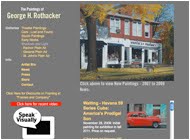George H. Rothacker, 2010©
SOLD
Owned by Mr. William Haines
Prints are available.
Please contact george@rothackeradv.com
The old American cars of Cuba, known as "cacharros," are not genuine classics but cobbled-together mongrels of different engines, gear boxes, body parts, seats, and windows, held together by frayed rubber bands, old rags, shoelaces and rusty plumbing tubes.
The Cuban government enforces a ban on buying and selling private cars produced after the 1959 Communist revolution. If you’re rich the ban doesn’t apply. Or at least it didn’t until March 2010, when a program allowing wealthier Cubans to import BMWs and Mercedes was abruptly stopped.
No-one knows why. If you’re a tourist it doesn’t apply either. You can hire a an Audi A4 from one of the state-owned rental agencies if you’re brave enough to navigate the unlit, unsigned streets and wobbling bicycle taxis. Or you can even rent a shiny full-working classic American convertible and rev it up on Havana’s coastal avenue, the Malecón.
Inevitably, this Cuban cliché will die with the Castros and the restrictions on buying and selling cars are loosened. But for now, the landscape remains rich with the rolling nostalgia of American past.
By the way, in the painting above, the '57 Ford and the '55 Pontiac existed in the same scene, whereas I replaced a more modern car with the '48 Chevy(?) in the rear and added the '49 Ford. Artistic license!





